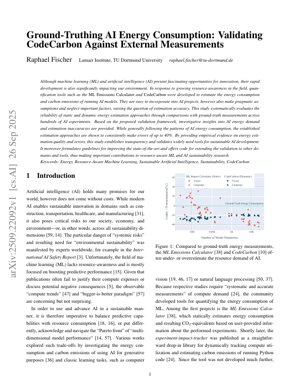Table of Contents
Estimation Error
Up to 40%
Maximum deviation from ground-truth measurements
Experiments
Hundreds
AI experiments conducted for validation
Tool Adoption
2M+
CodeCarbon downloads on PyPI
1 Introduction
Artificial intelligence presents significant environmental challenges despite its innovative potential. The rapid development of ML models has created substantial energy consumption concerns, with current estimation tools making pragmatic assumptions that may compromise accuracy. This study systematically validates static and dynamic energy estimation approaches against ground-truth measurements.
2 Methodology
2.1 Experimental Setup
The validation framework involved hundreds of AI experiments across computer vision and natural language processing tasks. Experiments were conducted using various model sizes from 10M to 10B parameters to capture scaling effects.
2.2 Measurement Framework
Ground-truth energy measurements were obtained using hardware power meters and system monitoring tools. Comparative analysis was performed between static (ML Emissions Calculator) and dynamic (CodeCarbon) estimation approaches.
3 Results and Analysis
3.1 Estimation Accuracy
Both estimation tools showed significant deviations from ground-truth measurements. The ML Emissions Calculator demonstrated under- and overestimation patterns ranging from -40% to +60% across different model types and sizes.
3.2 Error Patterns
Vision models showed different error patterns compared to language models. CodeCarbon generally provided more consistent estimates but still exhibited systematic errors up to 40% in certain configurations.
Key Insights
- Static estimation approaches are more prone to large errors with complex models
- Dynamic tracking provides better accuracy but still has systematic biases
- Model architecture significantly impacts estimation accuracy
- Hardware configuration variations contribute substantially to estimation errors
4 Technical Implementation
4.1 Mathematical Framework
The energy consumption of AI models can be modeled using the following equation:
$E_{total} = \sum_{i=1}^{n} P_i \times t_i + E_{static}$
Where $P_i$ represents the power consumption of component i, $t_i$ is the execution time, and $E_{static}$ accounts for baseline system energy consumption.
4.2 Code Implementation
Basic implementation of energy tracking using CodeCarbon:
from codecarbon import track_emissions
@track_emissions(project_name="ai_energy_validation")
def train_model(model, dataset, epochs):
# Model training code
for epoch in range(epochs):
for batch in dataset:
loss = model.train_step(batch)
return model
# Energy consumption tracking
with EmissionsTracker(output_dir="./emissions/") as tracker:
trained_model = train_model(resnet_model, imagenet_data, 100)
emissions = tracker.flush()5 Future Applications
The validation framework can be extended to other domains including reinforcement learning and generative models. Future work should focus on real-time energy optimization and hardware-aware model design. Integration with federated learning systems could enable distributed energy monitoring across edge devices.
Original Analysis: AI Energy Estimation Challenges and Opportunities
This study's findings highlight critical challenges in AI energy estimation that parallel issues in other computational domains. The observed 40% estimation errors are particularly concerning given the exponential growth in AI compute demand documented by researchers like Amodei and Hernandez (2018), who found AI compute requirements doubling every 3.4 months. Similar to how CycleGAN (Zhu et al., 2017) revolutionized image translation through cycle-consistent adversarial networks, we need fundamental innovations in energy measurement methodologies.
The systematic errors identified in both static and dynamic estimation approaches suggest that current tools fail to capture important hardware-software interactions. As noted in the International AI Safety Report (2023), environmental sustainability must become a primary consideration in AI development. The patterns observed in this study resemble early challenges in computer architecture performance prediction, where simple models often failed to account for complex cache behaviors and memory hierarchies.
Looking at broader computational sustainability research, the Energy Efficient High Performance Computing Working Group has established standards for measuring computational efficiency that could inform AI energy tracking. The $E_{total} = \sum P_i \times t_i + E_{static}$ formulation used in this study provides a solid foundation, but future work should incorporate more sophisticated models that account for dynamic voltage and frequency scaling, thermal throttling, and memory bandwidth constraints.
The study's validation framework represents a significant step toward standardized AI energy assessment, much like how ImageNet standardized computer vision benchmarks. As AI models continue to scale—with recent systems like GPT-4 estimated to consume energy equivalent to hundreds of households—accurate energy estimation becomes crucial for sustainable development. Future tools should learn from power modeling in high-performance computing while adapting to the unique characteristics of neural network inference and training.
6 References
- Amodei, D., & Hernandez, D. (2018). AI and Compute. OpenAI Blog.
- Zhu, J. Y., Park, T., Isola, P., & Efros, A. A. (2017). Unpaired Image-to-Image Translation using Cycle-Consistent Adversarial Networks. ICCV.
- International AI Safety Report (2023). Systemic Risks and Environmental Sustainability.
- Lacoste, A., et al. (2019). Quantifying the Carbon Emissions of Machine Learning. arXiv:1910.09700.
- Schwartz, R., et al. (2020). Green AI. Communications of the ACM.
- Energy Efficient High Performance Computing Working Group (2022). Standards for Computational Efficiency Metrics.
- Anthony, L. F. W., et al. (2020). Carbontracker: Tracking and Predicting the Carbon Footprint of Training Deep Learning Models. ICML Workshop.
Conclusion
This study establishes crucial empirical evidence for AI energy estimation quality, validating widely used tools while identifying significant accuracy limitations. The proposed validation framework and guidelines contribute substantially to resource-aware machine learning and sustainable AI development.
